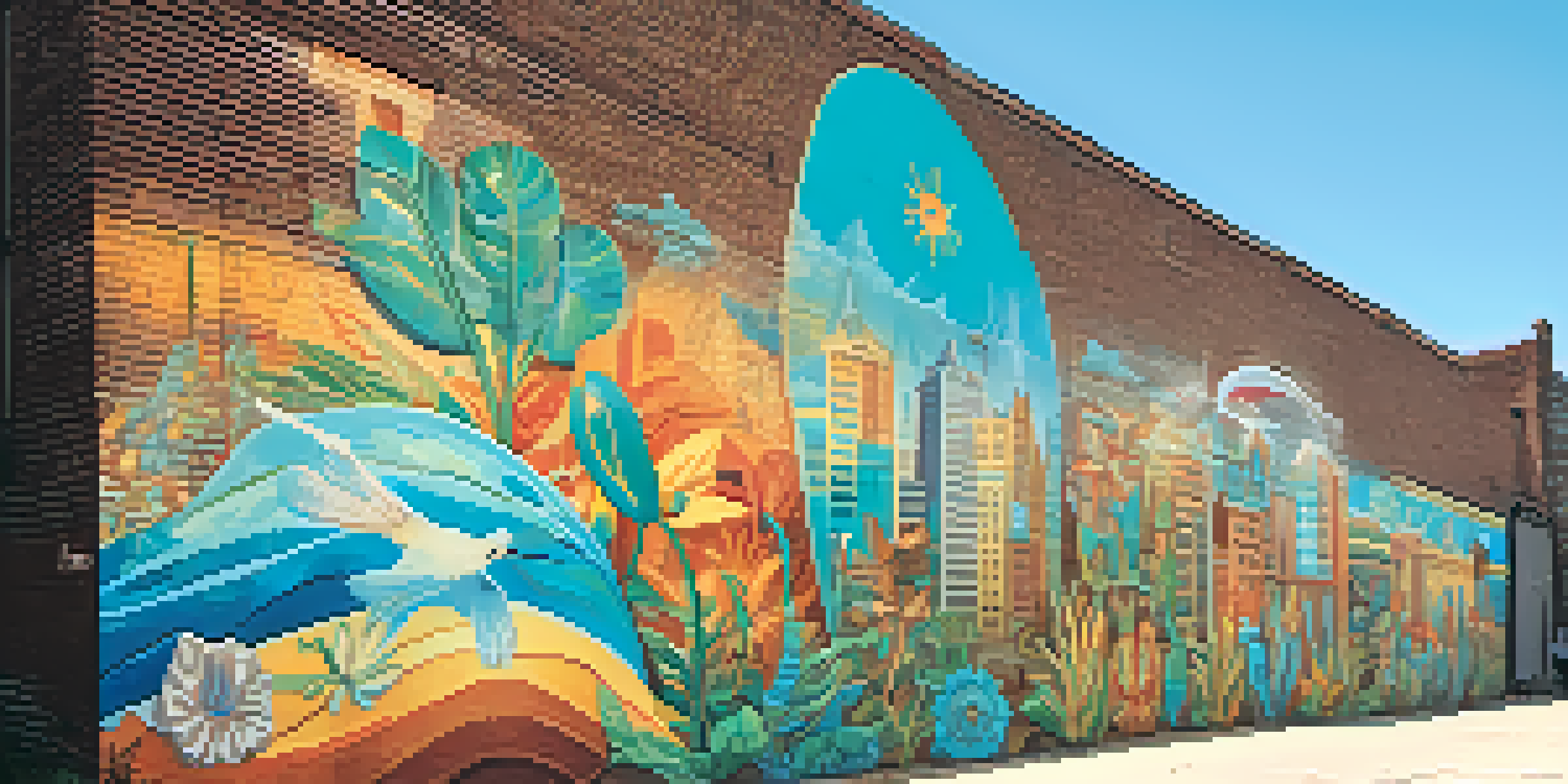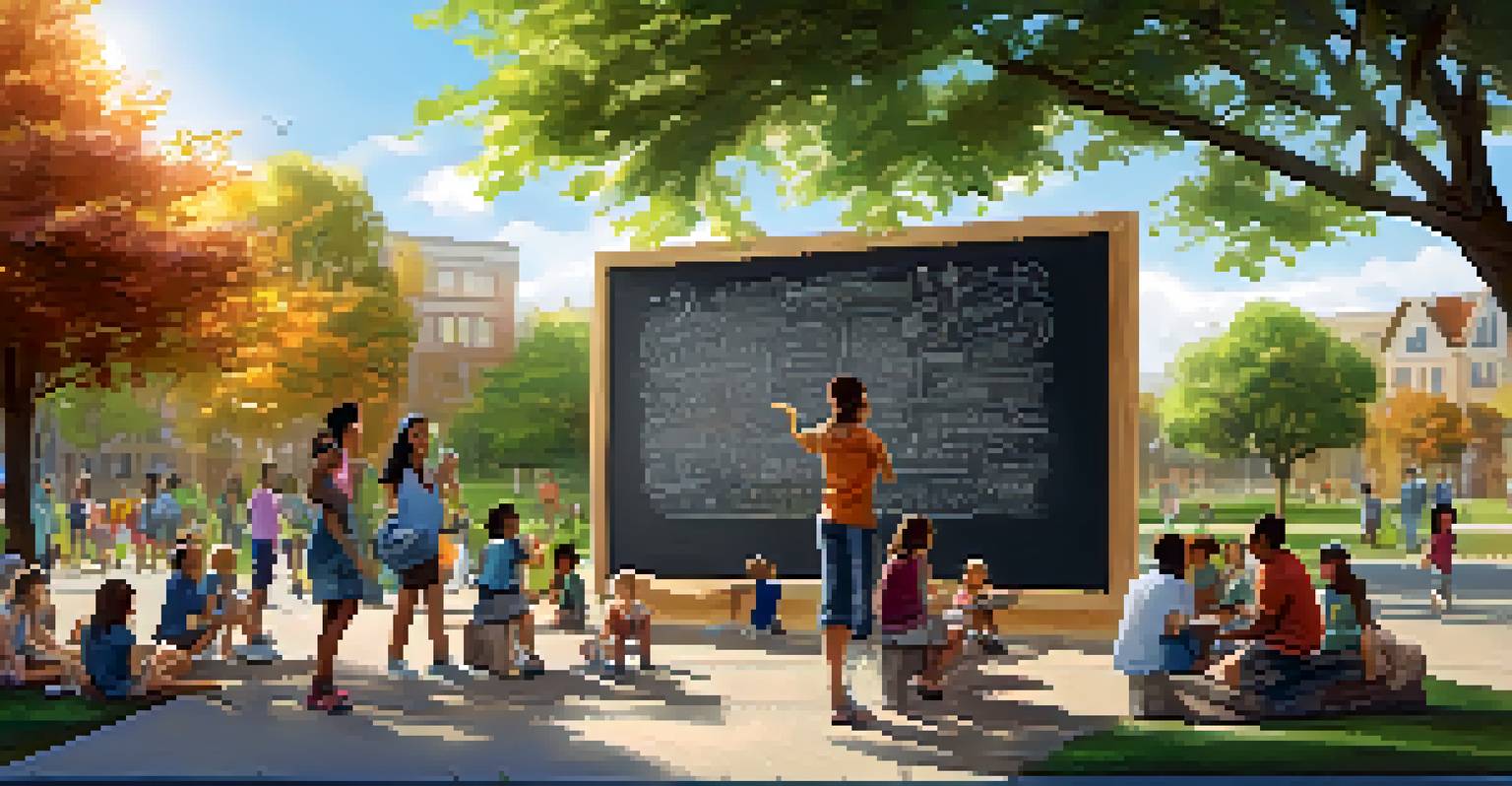Building Community Through Collaborative Public Art Installations

Understanding Collaborative Public Art Installations
Collaborative public art installations are unique projects where artists and community members come together to create something meaningful. These installations often reflect the culture, history, and values of the community, serving as a canvas for collective expression. By engaging various stakeholders, these projects foster a sense of ownership and pride among participants, making art a shared experience.
Art is the most beautiful of all lies; it is a lie that tells the truth.
One of the fascinating aspects of collaborative art is that it can take many forms, from murals and sculptures to interactive installations. This diversity in expression allows different voices to shine through, making the art more inclusive and representative of the community. Through this process, not only is art created, but also relationships and connections are built among participants.
In many cases, these installations can transform neglected spaces into vibrant community hubs. By beautifying public areas, they encourage social interaction and spark conversations, ultimately enhancing the communal atmosphere. This transformation is a powerful reminder of how art can breathe life into a neighborhood.
The Role of Community Engagement in Art Projects
Community engagement is crucial in the success of collaborative public art projects. Involving local residents from the very beginning ensures that the art truly resonates with the people it represents. This engagement can take various forms, such as workshops, surveys, or community meetings, allowing everyone to share their ideas and perspectives.

When community members participate in the creative process, they are more likely to feel a sense of ownership over the final piece. This sense of belonging can lead to increased pride in the community and strengthen social ties among residents. Engaged communities often report higher satisfaction and happiness, showcasing the positive impact of collaborative art on local well-being.
Art Builds Community Connections
Collaborative public art installations foster relationships and a sense of pride among community members through shared creative experiences.
Moreover, these projects can also serve as educational opportunities, teaching participants about art techniques and the importance of cultural expression. By providing a platform for learning, communities foster creativity and spark interest in the arts, which can benefit future generations.
Examples of Successful Collaborative Art Installations
One notable example is the 'Before I Die' wall, created by artist Candy Chang. This interactive installation invites passersby to share their personal aspirations on a public wall, encouraging dialogue and reflection within the community. It's a simple yet powerful way to engage people and promote shared experiences, illustrating the potential of collaborative art.
The best way to predict the future is to create it.
Another great case is the 'Mural Arts Philadelphia' program, which has transformed the city into an open-air gallery. Through partnerships with local artists and communities, this initiative has created thousands of murals that reflect the city’s diverse neighborhoods and histories. The murals not only beautify the spaces but also tell the stories of the people who live there.
These examples demonstrate that when art becomes a communal effort, it can lead to meaningful connections and a stronger sense of identity. By showcasing the talents and voices of community members, these installations foster a culture of collaboration and creativity.
Benefits of Collaborative Art for Community Building
Collaborative art installations provide numerous benefits beyond aesthetic appeal. They can enhance community cohesion by bringing people together around a common goal, creating bonds that might not have existed otherwise. As participants work side by side, they learn about each other’s backgrounds and experiences, fostering empathy and understanding.
Additionally, these projects can serve as a catalyst for local economic growth. By attracting visitors to view the installations, communities can stimulate local businesses and promote tourism. This, in turn, can lead to further investment in the area, creating a positive feedback loop of growth and development.
Engagement Enhances Project Success
Involving local residents in the artistic process ensures that the art resonates with the community and strengthens social ties.
Finally, the act of creating art together can be therapeutic. For many participants, expressing themselves through art can provide an outlet for emotions or a way to process shared experiences, especially in communities that have faced challenges. This healing aspect adds another layer of significance to collaborative public art.
Challenges in Implementing Collaborative Art Projects
While collaborative art installations have many benefits, they also come with their own set of challenges. One common hurdle is securing funding, as these projects often rely on grants or donations. Without adequate financial support, it can be difficult to bring a vision to life or cover the costs of materials and permits.
Furthermore, coordinating schedules and ensuring participation from diverse community members can be tricky. People have varying commitments, and finding a time that works for everyone can be a logistical nightmare. This can sometimes lead to frustration and disengagement if not managed carefully.
Lastly, there may be conflicts regarding artistic vision or differing opinions within the community. Navigating these differences requires strong communication and a willingness to compromise. It’s essential for organizers to foster an inclusive environment where all voices are heard, ensuring the final project reflects the collective vision.
The Impact of Public Art on Local Identity
Public art plays a significant role in shaping local identity and character. When communities come together to create art, they are not just making something beautiful; they are also telling their stories and celebrating their unique heritage. This shared narrative helps to build a sense of pride and belonging among residents.
Moreover, public art can serve as a visual reminder of the values and aspirations of a community. It can highlight important historical events, cultural milestones, or social issues that resonate with local residents. By reflecting these themes, public art becomes an integral part of the community's identity, fostering deeper connections among its members.
Public Art Shapes Local Identity
Public art reflects the history, culture, and values of a community, helping to build a shared narrative and a sense of belonging.
As communities evolve, so too does their public art. New installations can represent changing demographics, emerging voices, and current issues, ensuring that the art remains relevant. This dynamic relationship between public art and community identity keeps the conversation going and encourages ongoing collaboration.
Moving Forward: The Future of Collaborative Public Art
As cities and communities continue to grow, the role of collaborative public art is likely to expand. With advances in technology, there are now more ways than ever for artists and communities to collaborate on projects, from digital installations to augmented reality experiences. This evolution opens up exciting new possibilities for engagement and creativity.
Moreover, as societal issues become more pressing, collaborative public art can serve as a platform for activism and advocacy. By addressing topics such as climate change, social justice, and mental health, these projects can spark conversations and inspire action within communities. Art has always been a powerful tool for change, and its role in activism is only set to grow.

Ultimately, the future of collaborative public art will depend on continued community involvement and support. By prioritizing inclusivity and collaboration, these projects can strengthen community bonds and create lasting legacies that reflect the diverse voices of the people they represent.